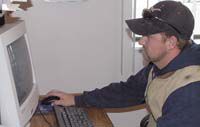| Buck Taylor sorts through applications at the Southeastern Utah Association of Local Governments weatherization program. Low income and elderly Carbon County residents may qualify to have homes prepared by licensed professionals for the winter weather. By performing several simple maintenance measures, local residents can reduce the cost associated with heating homes during the winter season |
With the climbing cost of natural gas, Carbon County residents are preparing to feel the impact of heating homes during the winter season. In order to reduce utility bills, people are advised to weatherize residences.
According to the United States Department of Energy, the typical American family spends more than $1,300 a year on energy bills. Some of the related costs are due to wasted energy. By weatherizing homes, local residents can cut the expense.
The Southeastern Association of Local Governments operates a weatherization department that assists low income families with the weatherization process. The department serves residents in Carbon, Emery, Grand and San Juan counties.
Therefore, the organization is feeling the impact of rising bills and colder weather.
In order to qualify for assistance, local residents must meet the program’s eligibility requirements.
If people meet the requirements, they will be placed on the ever growing waiting list, which is sorted by priority level.
Elderly citizens and persons with disabilities residing in the Castle Valley region will be placed on the top of the list.
“I think that every elderly person should try to qualify for the assistance,” suggested weatherization expert Buck Taylor. “We have gone and helped several elderly citizens already and they say that they can see and feel the difference already.”
The SEUAG program assists Carbon County residents who cannot afford or cannot complete the repairs.
However, all local residents can perform simple weatherization techniques that may reduce the cost of winter heating bills.
Taylor recommended that people in Carbon County regulate home thermostats.
The minimal comfortable temperature should be set and an even lower temperature may be set during the overnight hours.
“Another big thing is to keep utilities shut off when not in use,” pointed out Taylor. “Turn off lights when not in a room and lower the heating temperature.”
Sealing window and door frames with weatherstripping or caulk can also reduce the amount of cold air that enters a home and/or the amount of warm air that exits through these openings.
Homeowners should also check to see that their home is properly insulated. Poor insulation can lead to higher than normal heating bills.
It is also recommended that homeowner replace or clean their furnace filter. If the operation of the furnace is in question, homeowners may want to have an expert inspect the product to make sure that it is running properly and to it’s fullest capacity.
Local heating company’s also have available an equal payment plan. This plan ensures that users pay the same amount on their bill throughout the year. This saves money during peak months, but the cost is higher during the off season. For many local residents, this plan helps reduce the burden of higher utility bills during the holiday season.
Because heating costs are rising throughout the country, the Federal Trade Commission has issued a warning to consumers that alerts citizens of energy saving scams. The warning says to avoid purchasing energy saving products and services that are solicited over the phone or door-to-door.
The trade commission suggests that anyone who is interested in purchasing such a good or service check references, read energy saving claims carefully or contact the Better Business Bureau.
The SEUAG weatherization program is a safe way for Carbon County residents to benefit from energy saving products and services. Those who feel that they will qualify for the service should contact the organization for more information and an application. The center is located at the Carbon County Food Bank building in South Price.

